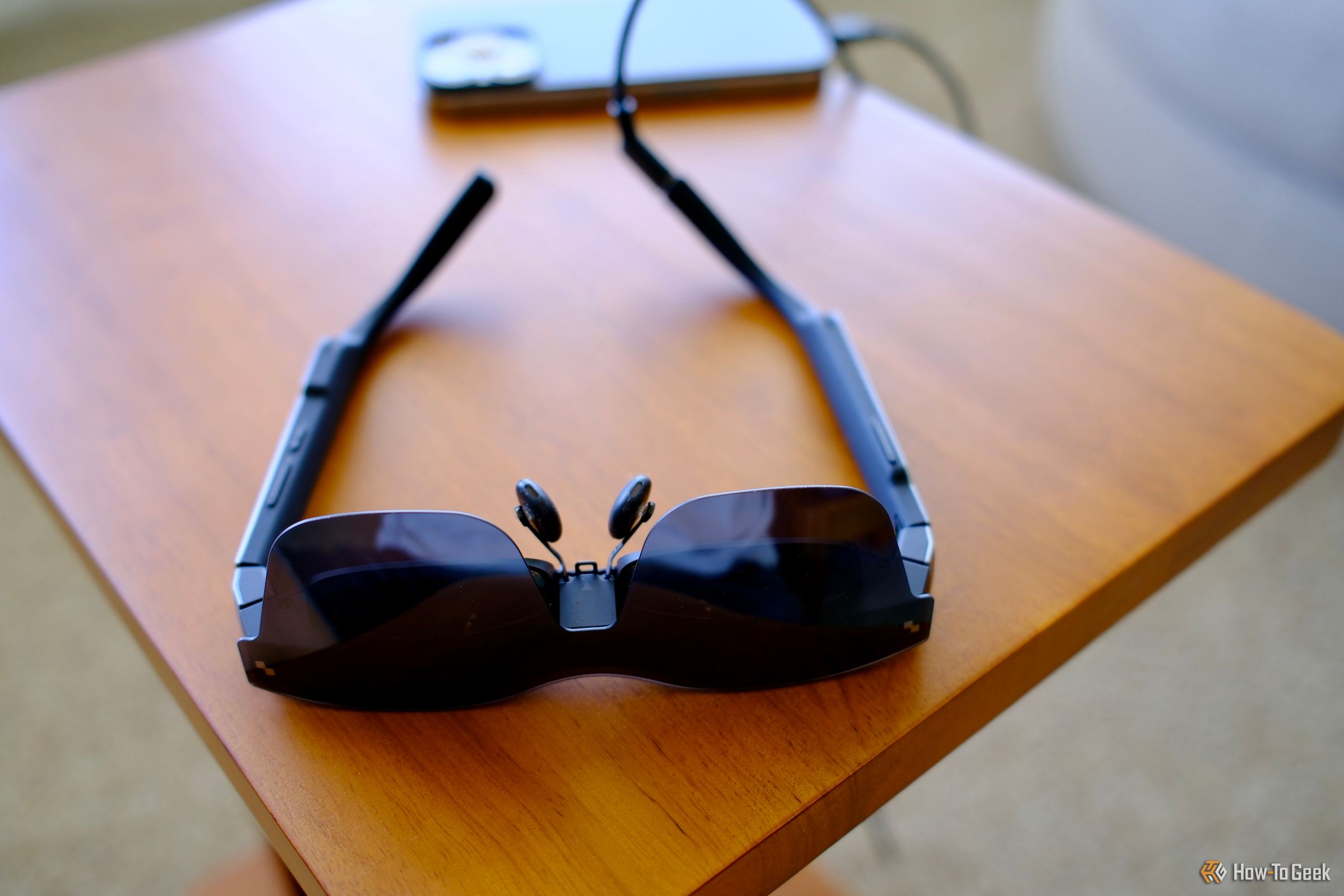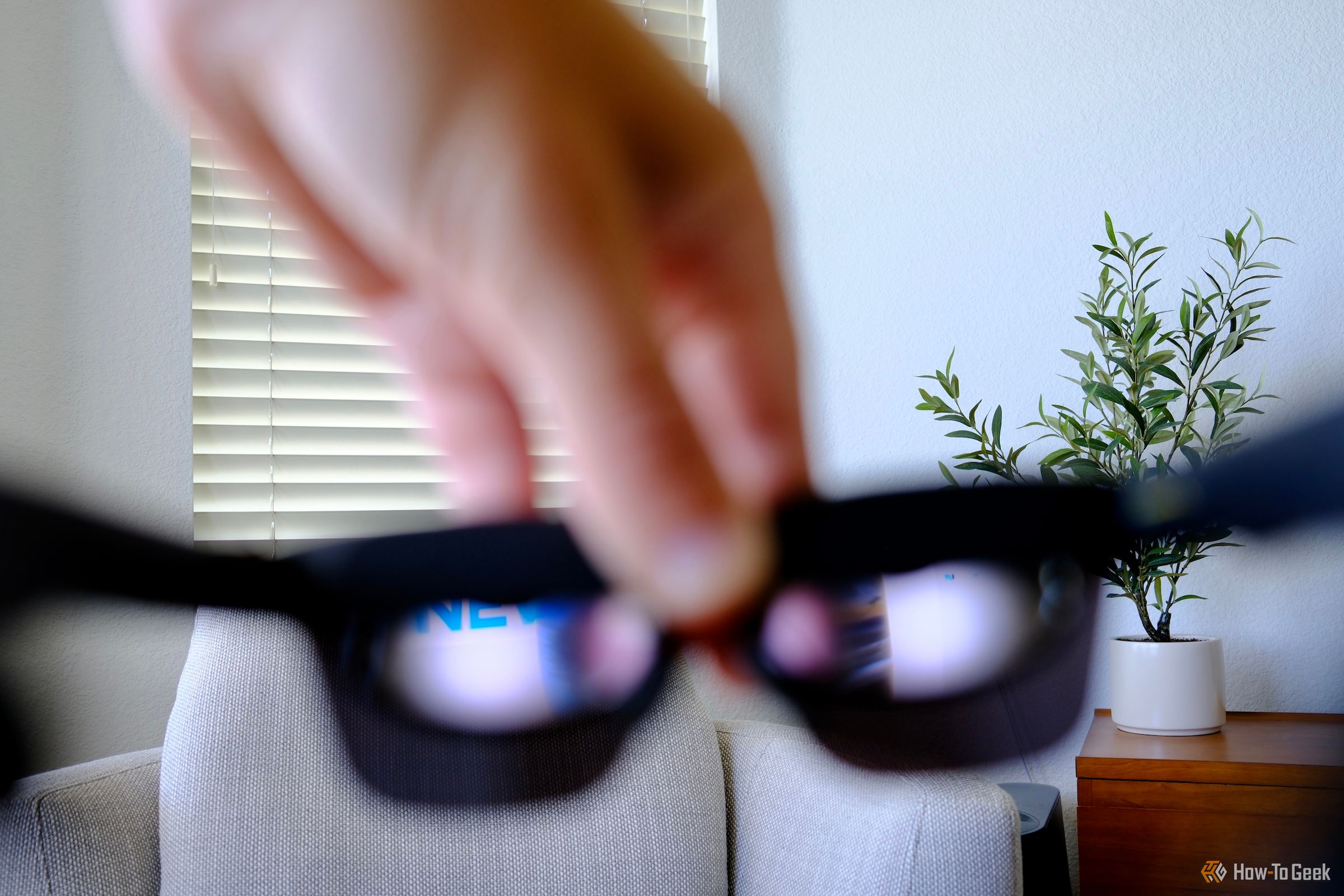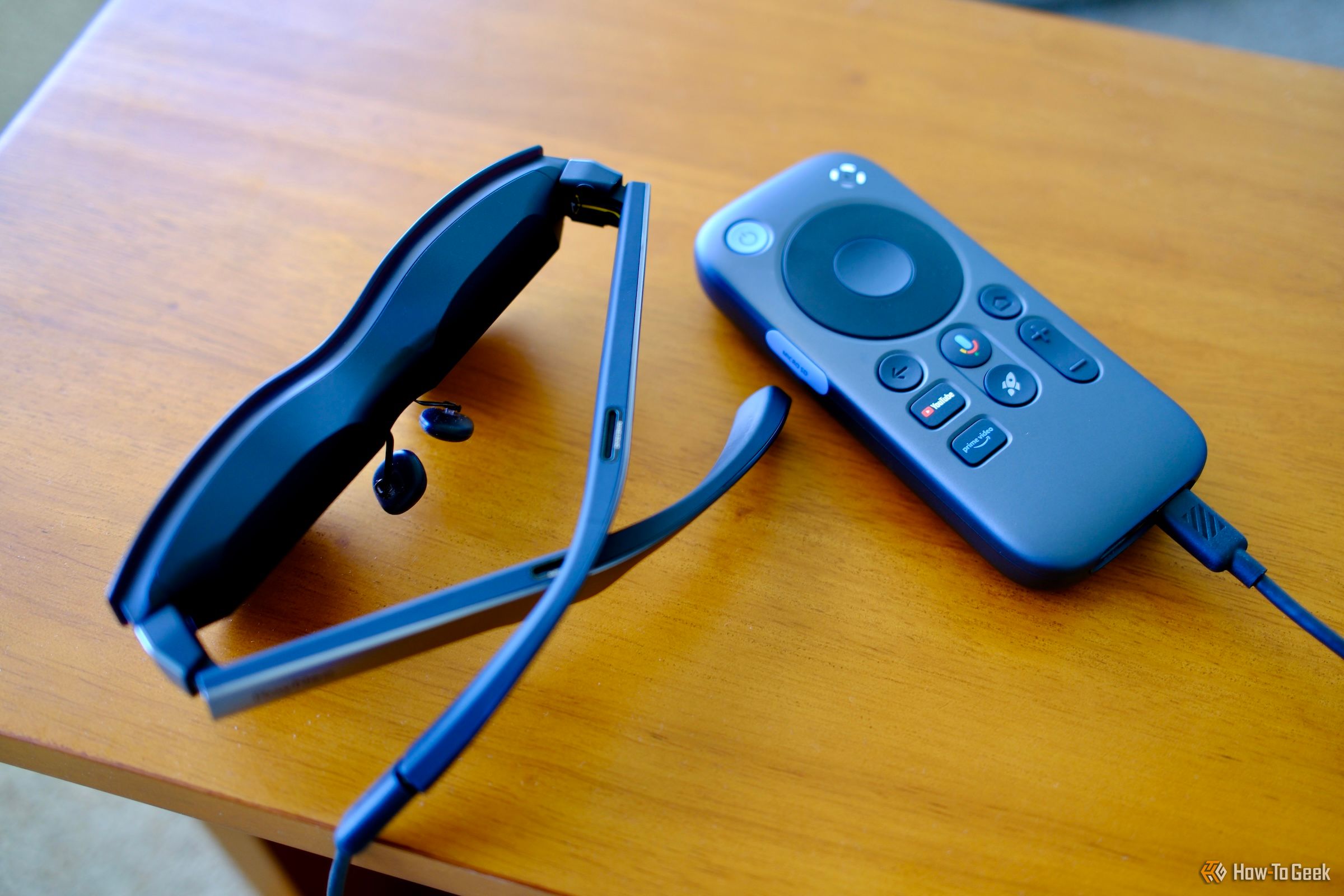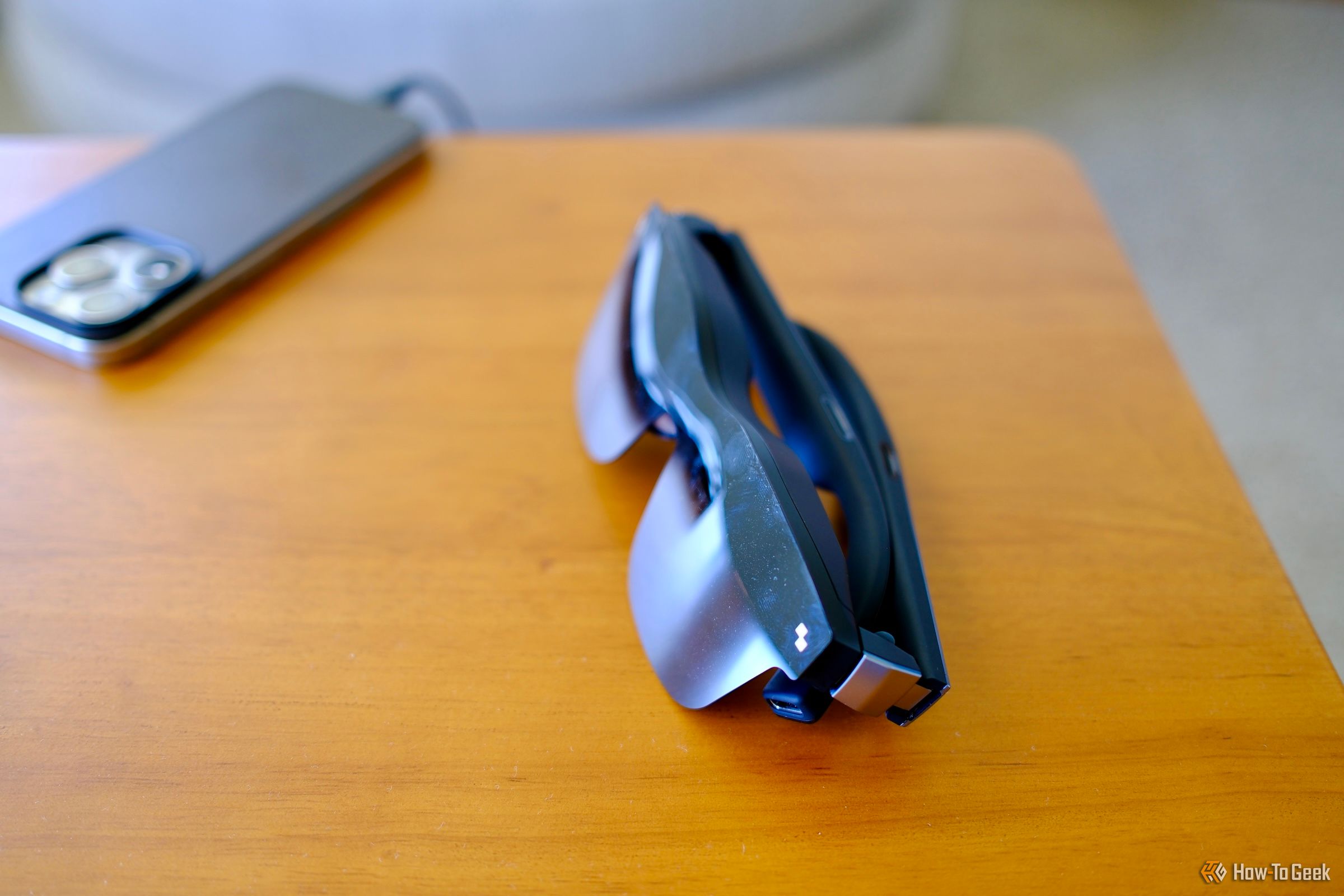Key Takeaways
- Smart projection glasses with great sound and bright screens, perfect for watching movies and Google TV content on the go.
- Upgraded speakers and higher resolution make the RayNeo Air 2S a slight improvement from previous models.
- Consider the RayNeo Pocket TV accessory for a more immersive streaming experience, especially for travelers.
More than anything, the RayNeo Air 2S glasses are great for watching movies, spatial videos, and Google TV wherever you want. The glasses aren’t virtual reality and don’t really have any augmenting skills, but that doesn’t mean they aren’t still worth wearing.
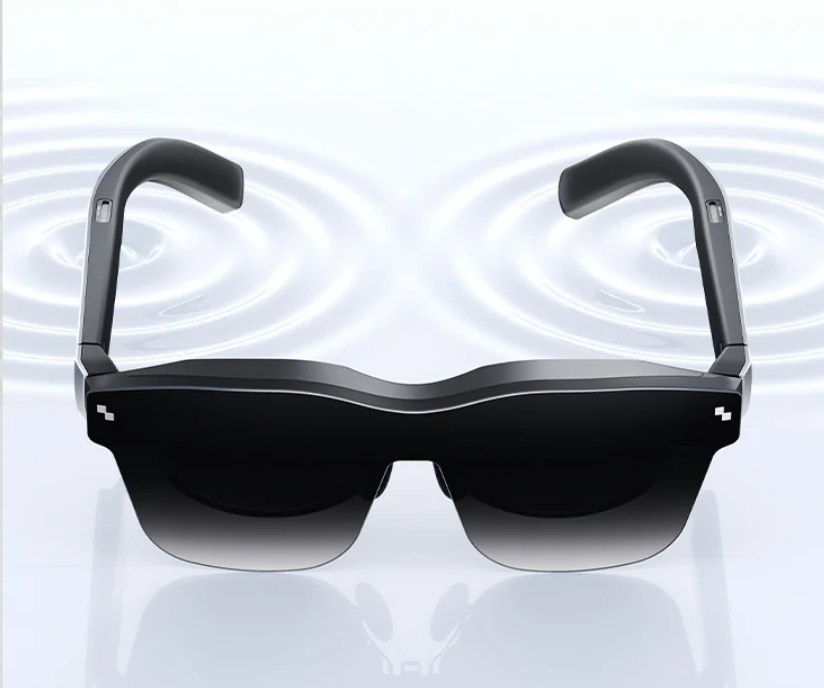
RayNeo Air 2S
Smart projection glasses capable of producing a 201-inch equivalent screen. The Air 2S includes an improved sound system with on-board brightness controls.
- Great sound with whisper mode
- screens get bright
- No need to recharge a battery
- Able to show Apple’s spatial videos
- Glasses still a bit bulky
- Compatibility for consoles need adapters
- Pocket TV accessory is nearly $200 additional cost
Price and Availability
The RayNeo Air2S glasses will be available for purchase starting August 15th. They’ll retail for $399. There are other accessories available for the glasses that you’ll need if you want to connect to a non-USB-C iPhone 15 or if you want to connect to a PlayStation 5, Xbox, or Switch.
What’s New in the Latest Model?
The RayNeo Air 2S glasses are new, but they’re only a slight revision from the RayNeo Air 2 model released not too long ago. The S in this new product means upgraded linear speakers (four in total) and a higher resolution (3,840 x 1,080) in 3D mode. That’s the meat of it. The new speakers sound great, but I wasn’t craving an improvement in sound. (Bluetooth earbuds are an option too.)
Previous owners of the Air 2 shouldn’t be jealous of the new frames, but new owners will get a few upgraded enhancements. The company says this should mean a more immersive experience, but it wasn’t too different from similar previous glasses. (And not even too dissimilar from the TCL NXTWEAR S glasses.)
As for the newest RayNeo Air 2S glasses, they weigh 78 grams and feature a pair of 16:9, 120Hz Sony Micro-OLED 1080p displays. They have a 46-degree field of view, have 49 pixels per degree, and show an equivalent 201-inch screen to the viewer. There’s a max brightness of 600 nits.
The glasses don’t have a battery and get their data and power over a removable USB-C cable. You can connect them to phones, computers, tablets, handheld gaming devices, or the RayNeo Pocket TV (stand-alone Google TV) to watch and play content. If you do want to connect the glasses to a Nintendo Switch you’ll need a special adapter. For a PlayStation or Xbox, you’ll also need a special HDMI adapter. Phones without a USB-C port will need an adapter too.
Instead of relying on a mobile app, all the controls can be accessed on the glasses, including changing the refresh rate from 60Hz to 120Hz, toggling the whisper mode to make the speakers quieter, color adjustment, and toggling between 2D and 3D. It didn’t take long to figure out the buttons on each of the stems but save for the volume, I didn’t access the other things much and had to re-remember them every couple of days.
TV and Movies Are the Best Parts
The technical aspects are one thing, but what can these glasses really do? Well, if you connect the RayNeo Air 2S glasses to a USB-C iPhone you’ll see your phone inside the lenses. If you start a Netflix movie, it will become widescreen, consuming your entire field of view, kind of like sitting in a movie theater—because the exterior glossy lens blocks out most of the light.
If you connect them to RayNeo’s Google TV device, you can stream shows and movies from nearly any service. This worked similarly to streaming from a phone but had a much better dedicated experience. The brightness level was great, even during the day. I don’t wear prescription glasses, but there’s an included piece in the box for that purpose if you do need it.
Connecting the glasses to my MacBook Air gave me a second monitor. I could either mirror my laptop’s display onto the glasses or add the glasses as a second screen. That was my preferred use because I would see Google Docs and work in Slack without anything being visible on my laptop’s screen in front of me.
It might not be a common need to have such privacy around work materials, but if you do travel frequently and need to work with sensitive data regularly, then the few hundred dollars of these glasses could be money well spent.
The RayNeo iOS app will add the ability to view 3D spatial videos taken on an iPhone 15 Pro or Vision Pro. Again, the use is a little niche, but it worked seamlessly, and I could play back spatial content without putting on the Vision Pro headset. (It’s a little surprising, but there is no Android app for the device currently.) Even if spatial videos aren’t commonplace yet, I like the feature inclusion. I don’t consider that gimmicky. I also liked that these glasses lacked some of the AR or “XR” stuff to add windows around your field of view.
Still, after all these different uses and scenarios, my favorite was the simplest. Using the Air 2S to watch shows was one of the easiest and most fulfilling. I could watch shows in bed without disturbing my wife. If the living room was occupied, I could pick up the glasses and get them going quickly.
I didn’t get to use the glasses with a console because I didn’t have the Joydock ($99) for the Nintendo Switch, but I think that could have been a fun use. If you do have a portable gaming device like a Steam Deck, that should work directly without a need for an adapter.
RayNeo Pocket TV Is (Probably) A Must-Have Accessory
The experience of connecting the Air 2S to my iPhone 15 Pro was fine. I had no issues doing so, but it was not my preferred use. Instead, I liked using the glasses with the RayNeo Pocket TV. It’s a small, fat remote control-looking device that the glasses plug into to access Google TV.
The Pocket TV has volume controls, a directional pad, shortcut buttons, and even a microSD expansion slot to load content for offline use. The device has an advertised battery life of five and a half hours, but I found that to be a little generous. Still, there’s plenty of time to watch a long movie. If you are stationary, there’s a secondary USB-C port on the Pocket TV to keep it powered.
I used the Pocket TV to stream shows from all kinds of apps, including the free Google channels. My favorite was using the MLB app on Google TV to watch baseball games. The four speakers were plenty loud and did have a convincing surround effect. Whisper mode worked well when I put the glasses on a family member and couldn’t hear much, even when they were close. I didn’t notice much of an impact on the sound I heard when I used the quieting mode, however.
Even though the Pocket TV adds a roughly $180 additional cost, the accessory still felt essential during my use. I didn’t have to worry about the glasses draining my phone’s battery or if I had all the streaming apps available on my phone. Google TV is a good enough streaming interface, with an abundance of content, that it makes the glasses feel like an entertainment machine.
Should You Buy the RayNeo Air 2S XR Glasses?
The RayNeo Air 2S glasses are a bit of a complicated product. The projection technology is a marvel, even if the frames aren’t the sleekest thing to wear ever. They were comfortable enough though. Plus, they’re easy to connect to a phone or laptop with a single USB-C cable. They’re always ready because they don’t have a battery that needs to be charged.
The problem is that using the glasses to watch a movie was not something I was drawn to most of the time. They were handy as a secondary option. But they were rarely my first choice for cinematic viewing when I didn’t need the seclusion.
Right now, in 2024, these are a product made for travelers or portable gamers. The glasses can be used at home, but it will feel like you’re getting the most value out of them, using them on a plane, in a hotel, or somewhere else out and bout where privacy might be needed. But if you are doing any streaming, be sure to consider the Pocket TV too, because it makes these glasses even more compelling.

RayNeo Air 2S
Smart projection glasses capable of producing a 201-inch equivalent screen. The Air 2S includes an improved sound system with on-board brightness controls.


